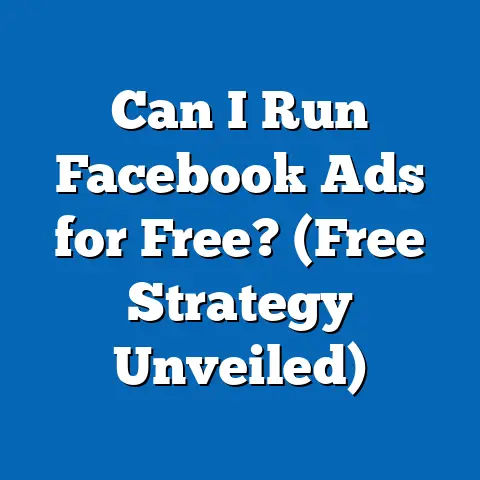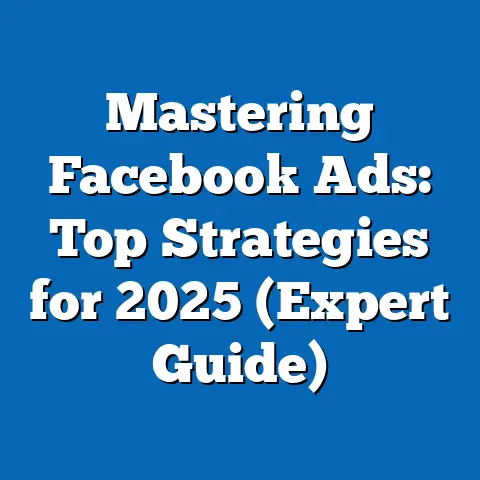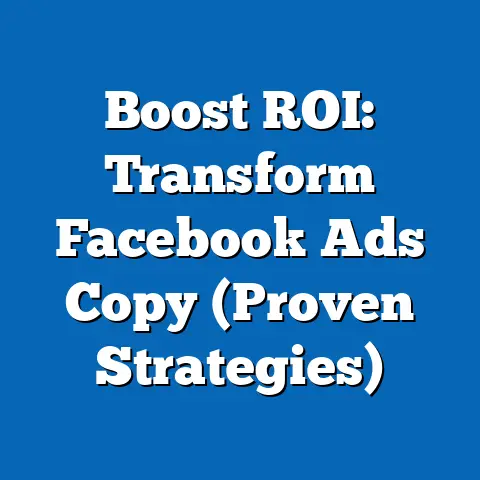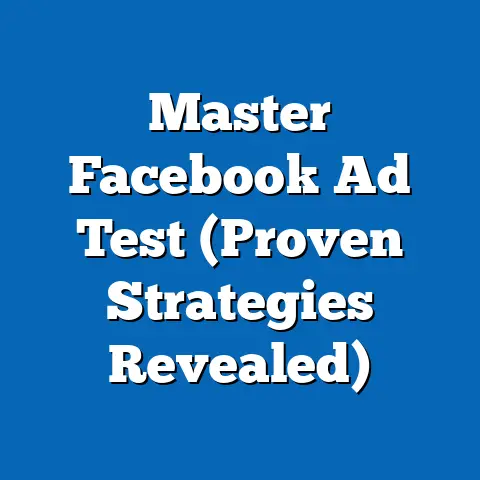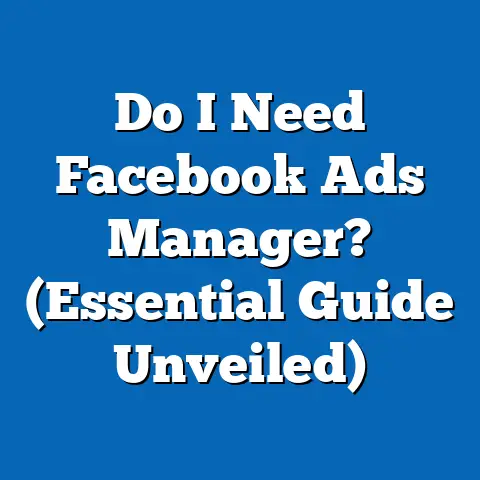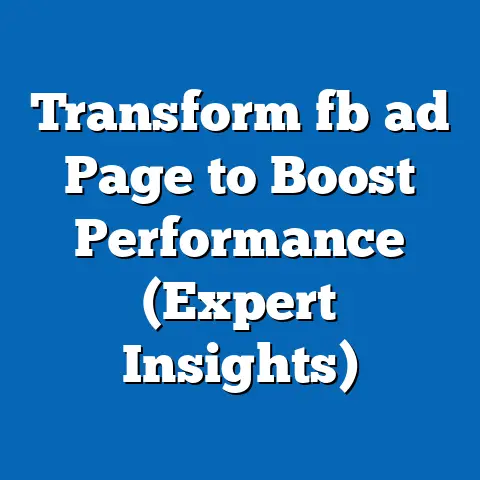Unlocking Facebook Ads Impressions (Pro Strategies Inside)
In today’s fiercely competitive digital landscape, Facebook Ads have become an indispensable tool for businesses aiming to boost their brand visibility and engage with their target audience. I’ve seen firsthand how a well-crafted Facebook ad campaign can catapult a brand from obscurity to the forefront of its niche. But simply creating an ad isn’t enough. The key lies in understanding and optimizing for impressions – the number of times your ad is displayed to potential customers. Think of impressions as the seeds you sow; the more seeds, the greater the chance of a bountiful harvest.
Impressions are a crucial key performance indicator (KPI) that offers valuable insights into your ad’s reach and potential impact. Without a healthy number of impressions, your message risks getting lost in the noise. Throughout my years in digital marketing, I’ve learned that mastering the art of increasing ad impressions is paramount to achieving successful advertising outcomes. This article isn’t just about theory; it’s a treasure trove of actionable pro strategies that I’ve personally used to skyrocket ad impressions and drive tangible results.
So, buckle up! We’re about to embark on a journey to unlock the secrets of Facebook Ads impressions and transform your advertising game. Get ready to discover how to fine-tune your targeting, craft compelling content, leverage the right ad formats, optimize ad delivery, and continuously monitor performance to maximize your ad’s impact. Let’s dive in and turn those impressions into real business growth!
Understanding Impressions in Facebook Ads
In the world of Facebook Ads, an “impression” is simply the number of times your ad is displayed on someone’s screen, whether they click on it or not. It’s the equivalent of a billboard on a busy highway – each time a car passes by, that’s one impression. It’s important to note that if the same person sees your ad multiple times, each view counts as a separate impression.
Impressions vs. Reach vs. Engagement
Often, people confuse impressions with reach and engagement, but they are distinct metrics.
- Reach is the unique number of people who saw your ad. If one person sees your ad five times, your reach is one, but your impressions are five.
- Engagement refers to the actions people take after seeing your ad, such as likes, comments, shares, and clicks.
Impressions are the foundation upon which reach and engagement are built. Without impressions, your ad won’t be seen, and therefore, it can’t generate reach or engagement. Think of it like this: impressions are the opportunity, reach is the audience, and engagement is the action taken by that audience.
How Facebook Calculates Impressions
Facebook uses a complex algorithm to determine when and where to show your ad. Several factors influence the number of impressions your ad receives:
- Budget: The more you spend, the more opportunities Facebook has to show your ad.
- Targeting: A well-defined target audience increases the likelihood of your ad being shown to relevant users.
- Ad Quality: Facebook assesses the quality and relevance of your ad. Higher quality ads are rewarded with more impressions.
- Bidding Strategy: Your bidding strategy influences how aggressively Facebook pursues impressions.
- Ad Schedule: The days and times you choose to run your ad can impact impression rates.
Facebook’s algorithm considers these factors in real-time to optimize ad delivery and ensure that ads are shown to the right people at the right time.
CPM (Cost Per Mille)
CPM, or Cost Per Mille (Mille is Latin for thousand), is a crucial metric directly related to impressions. It represents the cost you pay for one thousand impressions of your ad. CPM is a valuable indicator of the efficiency of your ad campaign. A lower CPM means you’re paying less for each thousand impressions, which is generally a good sign.
Here’s why CPM matters:
- Budgeting: CPM helps you estimate the cost of reaching a specific number of people.
- Comparison: It allows you to compare the cost-effectiveness of different ad campaigns and targeting strategies.
- Optimization: Monitoring CPM helps you identify areas where you can reduce costs and improve efficiency.
For example, if your CPM is $10, it means you pay $10 for every 1,000 impressions your ad receives. If you want to reach 100,000 people, you can estimate that it will cost you around $1,000 (100 x $10).
Takeaway: Understanding impressions, reach, engagement, and CPM is fundamental to mastering Facebook Ads. By focusing on increasing impressions while keeping CPM in check, you can maximize the impact of your advertising budget.
The Importance of Target Audience
I’ve learned over the years that targeting the right audience is not just important; it’s absolutely critical to the success of any Facebook ad campaign. It’s like fishing – you wouldn’t use the same bait to catch a trout as you would to catch a shark, right? The same principle applies to Facebook Ads. Showing your ad to the wrong people is like shouting into the void – you’ll get a lot of impressions, but very little return.
Facebook’s Audience Targeting Options
Facebook offers an array of powerful targeting options that allow you to pinpoint your ideal customers with remarkable precision. These options can be broadly categorized as:
- Demographics: Target users based on age, gender, location, education, relationship status, and job title.
- Interests: Reach users who have expressed interest in specific topics, hobbies, or brands.
- Behaviors: Target users based on their online behavior, such as purchase history, device usage, and travel habits.
- Custom Audiences: Upload your own customer data (email lists, phone numbers) to create custom audiences of existing customers or leads.
- Lookalike Audiences: Create audiences that are similar to your existing customers or website visitors.
Creating Detailed Buyer Personas
One of the most effective ways to refine your audience targeting is by creating detailed buyer personas. A buyer persona is a semi-fictional representation of your ideal customer, based on research and data about your existing customers.
Here’s how to create a buyer persona:
- Gather Data: Analyze your existing customer data, conduct surveys, and interview customers to gather insights into their demographics, interests, behaviors, and pain points.
- Identify Common Traits: Look for patterns and common characteristics among your customers.
- Create a Profile: Develop a detailed profile for each persona, including their name, age, occupation, goals, challenges, and motivations.
- Use Personas to Target Ads: Use your buyer personas to guide your audience targeting on Facebook. For example, if one of your personas is a “Tech-Savvy Millennial,” you might target users aged 25-34 who are interested in technology and online gaming.
Using Facebook’s Audience Insights Tool
Facebook’s Audience Insights tool is a goldmine of data that can help you understand your target audience and optimize your targeting strategies. This tool provides valuable insights into the demographics, interests, behaviors, and purchase habits of your target audience.
Here’s how to use Audience Insights:
- Access Audience Insights: Navigate to the Audience Insights tool within Facebook Ads Manager.
- Select Your Audience: Choose whether to analyze “Everyone on Facebook” or “People connected to your Page.”
- Explore Demographics: View detailed demographic information about your audience, including age, gender, location, education, and relationship status.
- Discover Interests: Identify the top interests and Pages that your audience likes.
- Analyze Behaviors: Explore the online behaviors of your audience, such as their purchase history and device usage.
- Use Insights to Optimize Targeting: Use the insights you gather to refine your audience targeting on Facebook.
Takeaway: Targeting the right audience is the cornerstone of successful Facebook advertising. By creating detailed buyer personas and leveraging Facebook’s Audience Insights tool, you can ensure that your ads are seen by the people who are most likely to be interested in your products or services. I can’t stress enough how much of a difference this makes!
Crafting Compelling Ad Content
Once you’ve identified your target audience, the next crucial step is to create compelling ad content that grabs their attention and drives engagement. I’ve seen countless ads that are perfectly targeted but fail to resonate with the audience because the content is bland, uninspired, or irrelevant. Think of your ad content as the hook that lures your target audience in.
Elements of High-Performing Ad Copy
High-performing ad copy is clear, concise, and persuasive. It speaks directly to the needs and desires of your target audience and compels them to take action. Here are some key elements to consider:
- Headline: Your headline is the first thing people see, so it needs to be attention-grabbing and relevant. Use strong verbs, numbers, and questions to pique interest.
- Body Text: The body text should provide more details about your offer and highlight the benefits of your product or service. Focus on solving your audience’s pain points and addressing their concerns.
- Call to Action (CTA): Your CTA tells people what you want them to do next, such as “Learn More,” “Shop Now,” or “Sign Up.” Use clear and concise language that creates a sense of urgency.
- Visuals: Choose high-quality images or videos that are visually appealing and relevant to your message. Use visuals to showcase your product, tell a story, or evoke emotion.
Examples of Successful Ad Creatives
Let’s take a look at some examples of successful ad creatives and analyze what makes them effective:
-
Example 1: Shopify
- Visual: A clean, professional image of a person working on a laptop, showcasing the Shopify platform.
- Headline: “Start Your Online Store Today”
- Body Text: “Shopify makes it easy to create a beautiful online store and start selling your products online.”
- CTA: “Start Free Trial”
- Why it works: The ad is visually appealing, the headline is clear and concise, and the body text highlights the benefits of using Shopify. The CTA is direct and encourages immediate action.
-
Example 2: Grammarly
-
Visual: A short, engaging video showcasing the features of Grammarly.
- Headline: “Improve Your Writing with Grammarly”
- Body Text: “Grammarly helps you write clearly and effectively, no matter where you’re writing.”
- CTA: “Get Grammarly”
- Why it works: The video is visually appealing and demonstrates the value of Grammarly. The headline is clear and concise, and the body text highlights the benefits of using Grammarly. The CTA is direct and encourages immediate action.
Example 1: Shopify
- Visual: A clean, professional image of a person working on a laptop, showcasing the Shopify platform.
- Headline: “Start Your Online Store Today”
- Body Text: “Shopify makes it easy to create a beautiful online store and start selling your products online.”
- CTA: “Start Free Trial”
- Why it works: The ad is visually appealing, the headline is clear and concise, and the body text highlights the benefits of using Shopify. The CTA is direct and encourages immediate action.
-
Example 2: Grammarly
-
Visual: A short, engaging video showcasing the features of Grammarly.
- Headline: “Improve Your Writing with Grammarly”
- Body Text: “Grammarly helps you write clearly and effectively, no matter where you’re writing.”
- CTA: “Get Grammarly”
- Why it works: The video is visually appealing and demonstrates the value of Grammarly. The headline is clear and concise, and the body text highlights the benefits of using Grammarly. The CTA is direct and encourages immediate action.
Example 2: Grammarly
Visual: A short, engaging video showcasing the features of Grammarly.
A/B Testing Ad Formats and Creatives
A/B testing, also known as split testing, is the process of comparing two versions of an ad to see which one performs better. It’s a powerful way to optimize your ad content and improve your results.
Here’s how to conduct A/B testing:
- Create Two Versions of Your Ad: Create two versions of your ad that are identical except for one element, such as the headline, image, or CTA.
- Run the Ads Simultaneously: Run both ads simultaneously to the same target audience.
- Track Performance: Track the performance of each ad, paying attention to metrics such as impressions, reach, CTR, and conversion rate.
- Analyze Results: Analyze the results to see which ad performed better.
- Implement the Winning Version: Implement the winning version of the ad and continue to test different elements to further optimize your results.
Takeaway: Crafting compelling ad content is essential for driving impressions and engagement. By focusing on creating clear, concise, and persuasive ad copy and using high-quality visuals, you can capture the attention of your target audience and compel them to take action. A/B testing is your secret weapon for continuously improving your ad content and maximizing your results. It’s a continuous process of refinement, but the payoff is well worth the effort.
Leveraging Facebook Ad Formats
Facebook offers a diverse range of ad formats, each with its own strengths and weaknesses. I’ve found that choosing the right ad format can significantly impact your impressions and engagement rates. It’s like choosing the right tool for the job – a hammer is great for nails, but not so great for screws.
Different Ad Formats
Here’s a rundown of the most popular Facebook ad formats:
- Image Ads: Simple ads that feature a single image and text. They are easy to create and can be very effective for showcasing products or services.
- Video Ads: Ads that feature a video. They are more engaging than image ads and can be used to tell a story or demonstrate a product in action.
- Carousel Ads: Ads that feature multiple images or videos in a carousel format. They are great for showcasing a range of products or telling a multi-part story.
- Slideshow Ads: Ads that combine multiple images into a slideshow with music. They are a cost-effective alternative to video ads.
- Collection Ads: Ads that allow users to browse and purchase products directly from the ad. They are ideal for e-commerce businesses.
- Instant Experience Ads: Full-screen ads that load instantly on mobile devices. They are highly immersive and engaging.
Impact on Impressions and Engagement
Different ad formats can have a different impact on impressions and engagement. For example, video ads tend to be more engaging than image ads, but they also require more effort to create. Carousel ads can showcase multiple products, which can increase the likelihood of a user finding something they like.
Here’s a general guideline:
- Image Ads: Good for simple messages and showcasing individual products.
- Video Ads: Excellent for storytelling and demonstrating product features.
- Carousel Ads: Ideal for showcasing a range of products or services.
- Slideshow Ads: A cost-effective alternative to video ads.
- Collection Ads: Best for e-commerce businesses looking to drive sales.
- Instant Experience Ads: Great for creating immersive and engaging experiences on mobile devices.
Choosing the Right Ad Format
The best ad format for your campaign depends on your goals, your target audience, and your budget.
Here are some factors to consider:
- Campaign Goals: What do you want to achieve with your ad campaign? Are you looking to increase brand awareness, drive website traffic, generate leads, or drive sales?
- Target Audience: What are the preferences of your target audience? Do they prefer to watch videos or browse images?
- Budget: How much are you willing to spend on your ad campaign? Video ads and Instant Experience ads tend to be more expensive than image ads.
Case Studies
-
Case Study 1: Fashion Retailer
- Goal: Increase sales of new clothing line.
- Ad Format: Carousel Ads
- Results: The retailer used carousel ads to showcase multiple items from their new clothing line. This allowed them to highlight the diversity of their collection and increase the likelihood of users finding something they liked. They saw a 30% increase in sales compared to using single image ads.
-
Case Study 2: Software Company
-
Goal: Generate leads for their software product.
- Ad Format: Video Ads
- Results: The software company created a short, engaging video that demonstrated the key features of their product. They used the video ad to drive traffic to their website and generate leads. They saw a 50% increase in leads compared to using image ads.
Case Study 1: Fashion Retailer
- Goal: Increase sales of new clothing line.
- Ad Format: Carousel Ads
- Results: The retailer used carousel ads to showcase multiple items from their new clothing line. This allowed them to highlight the diversity of their collection and increase the likelihood of users finding something they liked. They saw a 30% increase in sales compared to using single image ads.
-
Case Study 2: Software Company
-
Goal: Generate leads for their software product.
- Ad Format: Video Ads
- Results: The software company created a short, engaging video that demonstrated the key features of their product. They used the video ad to drive traffic to their website and generate leads. They saw a 50% increase in leads compared to using image ads.
Case Study 2: Software Company
Goal: Generate leads for their software product.
Takeaway: Choosing the right ad format is crucial for maximizing your impressions and engagement rates. By considering your campaign goals, target audience, and budget, you can select the ad format that is most likely to deliver the results you’re looking for. Don’t be afraid to experiment with different formats to see what works best for your business.
Optimizing Ad Delivery
Facebook’s ad delivery system is a complex beast, but understanding how it works is essential for maximizing your ad impressions. I’ve seen campaigns that were perfectly targeted and had compelling content, but still underperformed because the ad delivery was poorly optimized. Think of it as having a great product but not knowing how to get it to the right customers.
Facebook’s Ad Delivery System
Facebook’s ad delivery system is designed to show your ad to the people who are most likely to be interested in it. The system considers several factors, including your budget, your bid, your target audience, and the quality of your ad.
Bidding Strategy
Your bidding strategy influences how aggressively Facebook pursues impressions. You have two main options:
- Automatic Bidding: Facebook automatically sets your bid based on your budget and your campaign goals. This is a good option for beginners or for campaigns where you don’t have a lot of data to work with.
- Manual Bidding: You manually set your bid for each impression. This gives you more control over your ad delivery, but it also requires more expertise and monitoring.
Ad Placement Options
Facebook offers a variety of ad placement options, including:
- Facebook Feed: The main news feed on Facebook.
- Instagram Feed: The main news feed on Instagram.
- Facebook Marketplace: A marketplace where users can buy and sell items.
- Facebook Stories: Short-form videos and images that disappear after 24 hours.
- Instagram Stories: Short-form videos and images that disappear after 24 hours.
- Audience Network: A network of websites and apps that partner with Facebook to display ads.
Choosing the right ad placement options can significantly impact your impression rates. For example, if you’re targeting a younger audience, you might want to focus on Instagram Feed and Instagram Stories.
Frequency Management
Frequency management is the practice of limiting the number of times a user sees your ad. This is important because showing the same ad to the same person too many times can lead to ad fatigue and decreased engagement.
Facebook allows you to set a frequency cap for your ad campaigns. This is the maximum number of times a user will see your ad in a given period of time. I generally recommend setting a frequency cap of 3-5 impressions per week.
Takeaway: Optimizing your ad delivery is crucial for maximizing your impressions and engagement rates. By choosing the right bidding strategy, ad placement options, and frequency cap, you can ensure that your ads are seen by the right people at the right time. It’s all about finding the sweet spot where your ads are visible without becoming intrusive.
Monitoring and Analyzing Performance
No Facebook ad campaign is complete without continuous monitoring and analysis. I’ve learned that even the most meticulously planned campaigns can benefit from ongoing adjustments based on real-time data. It’s like navigating a ship – you need to constantly monitor the compass and adjust your course to stay on track.
Key Metrics to Track
Here are some key metrics to track to monitor your ad performance:
- Impressions: The number of times your ad is displayed.
- Reach: The number of unique people who saw your ad.
- CTR (Click-Through Rate): The percentage of people who clicked on your ad after seeing it.
- Engagement Rate: The percentage of people who interacted with your ad (likes, comments, shares).
- CPM (Cost Per Mille): The cost you pay for one thousand impressions of your ad.
- CPC (Cost Per Click): The cost you pay for each click on your ad.
- Conversion Rate: The percentage of people who completed a desired action after clicking on your ad (e.g., making a purchase, filling out a form).
- Return on Ad Spend (ROAS): The amount of revenue you generate for every dollar you spend on advertising.
Tools and Analytics
Facebook Ads Manager provides a wealth of tools and analytics for monitoring and analyzing your ad performance. You can use these tools to track your key metrics, identify trends, and make data-driven decisions.
Here are some of the tools available within Facebook Ads Manager:
- Reporting Dashboard: A customizable dashboard that allows you to track your key metrics in real-time.
- Attribution Tool: A tool that helps you understand which ads are driving conversions.
- A/B Testing Tool: A tool that allows you to test different versions of your ad to see which one performs better.
- Audience Insights Tool: A tool that provides valuable insights into the demographics, interests, and behaviors of your target audience.
Interpreting Data and Adjusting Strategies
The key to successful Facebook advertising is to use the data you collect to continuously improve your campaigns. Here are some tips for interpreting data and adjusting your strategies:
- Identify Trends: Look for trends in your data to see what’s working and what’s not.
- Compare Performance: Compare the performance of different ad campaigns, ad sets, and ads to identify areas for improvement.
- A/B Test Everything: A/B test different elements of your ad campaigns to see what resonates best with your target audience.
- Adjust Your Budget: Adjust your budget based on the performance of your ad campaigns.
- Refine Your Targeting: Refine your targeting based on the demographics, interests, and behaviors of the people who are engaging with your ads.
- Update Your Ad Content: Update your ad content to keep it fresh and relevant.
Takeaway: Continuous monitoring and analysis are essential for maximizing the impact of your Facebook ad campaigns. By tracking your key metrics, using the tools and analytics available within Facebook Ads Manager, and interpreting the data to adjust your strategies, you can ensure that your ads are performing at their best. It’s a cycle of continuous improvement that can lead to significant gains in your advertising ROI.
I want to reiterate that impressions are the lifeblood of any successful Facebook ad campaign. They represent the opportunity to connect with potential customers, build brand awareness, and drive meaningful results. By implementing the pro strategies discussed in this article, you can effectively unlock your ad impressions and transform your advertising outcomes.
Remember, mastering Facebook Ads is not a one-time achievement but a continuous journey. The platform is constantly evolving, and new features and best practices are emerging all the time. Stay curious, keep experimenting, and never stop learning. The more you invest in understanding the intricacies of Facebook Ads, the greater the returns you’ll see for your brand.
So, go forth and put these strategies into action! I’m confident that with dedication and a data-driven approach, you can achieve substantial growth and success for your brand through the power of Facebook Ads. The digital world is waiting, and your brand’s story deserves to be heard. Now, go make some impressions!

